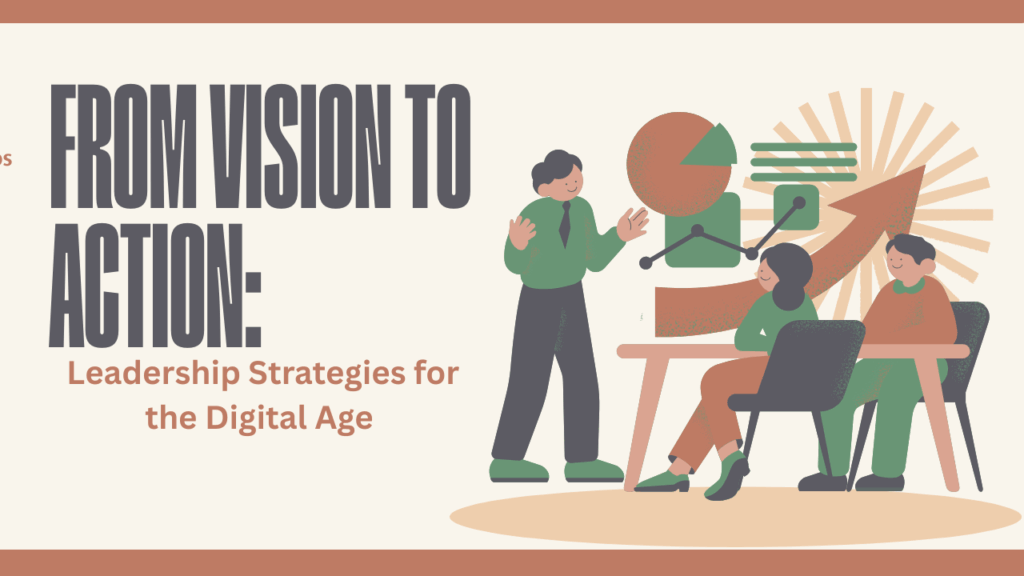The digital age has fundamentally transformed the way organizations operate. Rapid technological advances, remote work, AI integration, and data-driven decision-making demand leaders who can translate vision into actionable strategies. Modern leaders must balance innovation, agility, and human-centric leadership to inspire teams and achieve organizational goals.
This article explores key leadership strategies, emerging trends, benefits, and challenges for leading effectively in today’s digital landscape.
Understanding Digital-Age Leadership
Digital-age leadership is not just about managing technology—it’s about guiding people through rapid change, complexity, and uncertainty. Leaders must embrace data-driven insights, collaboration, and adaptability while fostering a culture of innovation and resilience.
Key traits of digital-age leaders include:
- Visionary thinking: Ability to see opportunities in disruption.
- Agility: Quick decision-making and flexibility in changing conditions.
- Emotional intelligence: Leading with empathy and understanding.
- Tech fluency: Understanding digital tools and platforms that drive efficiency.
Key Leadership Strategies for the Digital Age
- Embrace Data-Driven Decision Making
Digital leaders rely on analytics and AI tools to make informed decisions. By leveraging real-time data, leaders can identify trends, forecast outcomes, and optimize resources.
Example: Using AI-driven dashboards to track team performance and adjust project priorities efficiently.
- Foster a Culture of Innovation
Encouraging creativity, experimentation, and risk-taking allows organizations to stay competitive. Leaders can implement innovation labs, hackathons, and collaborative platforms to surface ideas and solutions from across the organization.
Impact: Drives product development, process improvements, and a proactive organizational mindset.
- Develop Agile Leadership Practices
Agility is essential in the fast-moving digital landscape. Leaders should adopt iterative planning, adaptive workflows, and rapid feedback loops to respond to market changes and operational challenges.
Example: Implementing short-cycle project reviews and pivoting strategies based on real-time results.
- Enhance Emotional Intelligence (EQ)
Empathy, active listening, and relationship-building remain critical in digital-first workplaces. Leaders who demonstrate high EQ build trust, inspire engagement, and strengthen team cohesion, especially in remote or hybrid environments.
Impact: Improved morale, collaboration, and employee retention.
- Leverage Technology for Collaboration
Digital leaders must use modern tools to enable seamless communication and collaboration. Cloud platforms, project management software, and AI-enabled collaboration tools help teams stay connected, productive, and aligned.
- Invest in Continuous Learning
The digital age demands lifelong learning. Leaders must stay updated on emerging technologies, management practices, and industry trends, while promoting a learning culture among teams.
Impact: Future-ready teams, reduced skill gaps, and enhanced organizational adaptability.
- Strategic Vision to Execution
Digital leaders translate vision into action by setting clear goals, defining KPIs, and ensuring accountability. They align teams around objectives, communicate priorities, and continuously track progress to deliver measurable results.
Example: Rolling out a digital transformation initiative with defined milestones and performance metrics.

Benefits of Effective Digital-Age Leadership
- Enhanced Organizational Agility: Quickly respond to market changes and disruptions.
- Higher Employee Engagement: EQ-driven leadership fosters motivation and loyalty.
- Innovation & Growth: Encourages creativity and continuous improvement.
- Data-Driven Performance: Decisions backed by analytics improve efficiency and outcomes.
- Future-Proofed Workforce: Continuous learning ensures readiness for emerging challenges.
Challenges for Digital Leaders
- Rapid Technological Changes: Keeping pace with AI, automation, and digital tools.
- Managing Remote Teams: Ensuring collaboration and cohesion in hybrid environments.
- Change Management Resistance: Employees may struggle with new workflows and systems.
- Balancing People and Technology: Integrating digital tools without losing human connection.
- Cybersecurity & Ethical Concerns: Navigating data privacy, ethical AI, and compliance.
Strategies to Overcome Leadership Challenges
- Adopt Transparent Communication: Keep teams informed and engaged in change initiatives.
- Upskill Continuously: Invest in training for both leaders and employees.
- Encourage Cross-Functional Collaboration: Break down silos to promote innovation.
- Use Feedback Loops: Regularly collect input from teams to improve processes and strategies.
- Foster a Resilient Mindset: Develop adaptability to face setbacks and uncertainty.
Case Examples of Digital-Age Leadership
- Tech Industry: Leaders at AI-driven companies use data analytics to optimize product development cycles.
- Healthcare: Hospital administrators adopt digital patient management systems to enhance care efficiency.
- Finance: Executives leverage blockchain and automation to streamline operations while ensuring compliance.
Final Words
Leading in the digital age is about turning vision into measurable action, inspiring teams, and leveraging technology responsibly. Organizations that cultivate strong digital-age leaders gain a competitive edge, drive innovation, and future-proof their workforce.
At Ebullient, we specialize in leadership training and organizational development programs designed for the digital era. Our tailored workshops, AI-driven learning solutions, and immersive coaching experiences help leaders develop the skills, mindset, and strategies needed to thrive in a complex, digital-first world.
Discover how we can transform your leadership capabilities at ebullient and take the first step toward building a resilient, innovative, and future-ready organization.
FAQ – Leadership in the Digital Age
- What makes digital-age leadership different from traditional leadership?
It emphasizes agility, tech literacy, data-driven decision-making, and adaptability while maintaining human-centric leadership principles. - How can leaders foster innovation in their teams?
By encouraging experimentation, providing safe spaces for idea generation, and supporting collaboration across functions. - Why is emotional intelligence important in the digital workplace?
High EQ builds trust, improves engagement, and strengthens relationships, especially in remote or hybrid settings. - How can leaders stay updated on digital trends?
Participate in workshops, online courses, industry conferences, and learning programs offered by organizations like Ebullient. - What are common challenges in implementing digital strategies?
Rapid tech changes, resistance to change, remote team management, cybersecurity concerns, and balancing tech with human connection.



